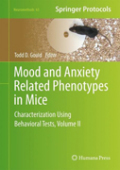
Mood and anxiety related phenotypes in mice v. II Characterization using behavioral tests
Gould, Todd D.
Preclinical research related to mood and anxiety disorders relies extensivelyupon mouse behavioral tests and models, the use of which continues to increase as a greater number of underlying susceptibility genes are discovered, new targets for medications are identified, and clinical studies reveal novel neurobiological risk factors. Mood and Anxiety Related Phenotypes in Mice: Characterization Using Behavioral Tests, Volume II serves as a complement to the previous volume in order to offer a comprehensive resource for the behavioral approaches that are valuable for the characterization of mood and anxiety disorder-related behaviors in mice and the techniques that are utilized in the development of effective medications. As a collection presented in the Neuromethods series, each chapter provides a brief background and review of the test or model as well as a complete and up-to-date protocol narrative. Authoritative and comprehensive, Mood and Anxiety Related Phenotypes in Mice: Characterization Using Behavioral Tests, Volume II is an ideal resource for scientists actively pursuing or interested in establishing vital behavioral protocols in their laboratories. Presents complete, current, and up-to-date collection of methods, protocols, and reviews. Contributed by world-renowned scientists with broad experiences in the development and application of behavioral tasks in mice. Includes clear and concise guides to experimentation. INDICE: Longitudinal Assessment of Deliberate Mouse Behavior in the Home Cage and Attached Environments: Relevance to Anxiety and Mood Disorders. Using Behavioral Patterns Across Species in Mood Disorder Research. Telemetry in Mice: Applications in Studies of Stress and Anxiety Disorders. Modeling Mouse Anxiety and Sensorimotor Integration: Phenotypes in the Suok Test. Assessment of Social Approach Behavior in Mice. The Mouse Defense Test Battery: A Model Measuring Different Facets of Anxiety-Related Behaviors. Novelty-Suppressed Feeding in the Mouse. The Four-Plate Test in Mice. The Vogel Punished Drinking Task as a Bioassay of Anxiety-Like Behavior of Mice. A Vogel Conflict Test Using Food Reinforcement in Mice. Fear Conditioning and Extinction as a Model of PTSD in Mice. The “Cut-off Behavioral Criteria” Method: Modeling Clinical Diagnostic Criteria in Animal Studies of PTSD. Measuring Variations in Maternal Behavior: Relevance for Studies of Mood and Anxiety. Emotionality-Related Consequences of Early Weaning in Mice and Rats. Separation-Induced Depression in the Mouse. Induction of Persistent Depressive-Like Behavior by Corticosterone. The Olfactory Bulbectomized Mouse. Differential-Reinforcement-of-Low-Rate Behavior inRodents as a Screen for Antidepressant Efficacy. The Intracranial Self-Stimulation Procedure Provides Quantitative Measures of Brain Reward Function. The Female Urine Sniffing Test (FUST) of Reward Seeking Behavior. Measuring Impulsive Choice Behaviour in Mice. Assessment of Male Sexual Behavior in Mice.
- ISBN: 978-1-61779-312-7
- Editorial: Humana Press
- Encuadernacion: Cartoné
- Páginas: 331
- Fecha Publicación: 28/10/2011
- Nº Volúmenes: 1
- Idioma: Inglés
